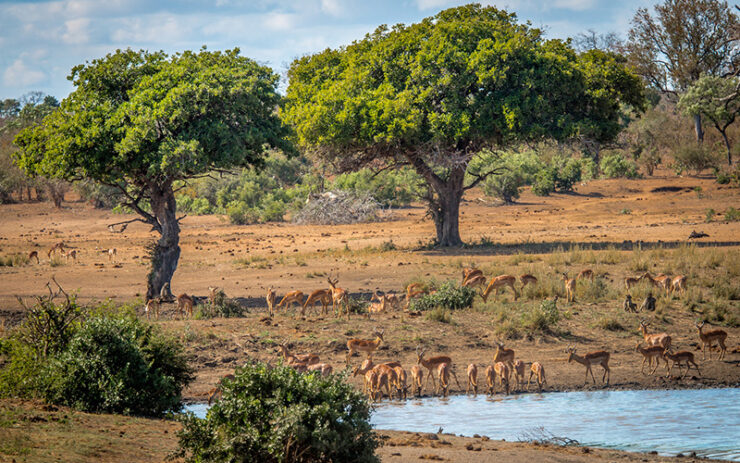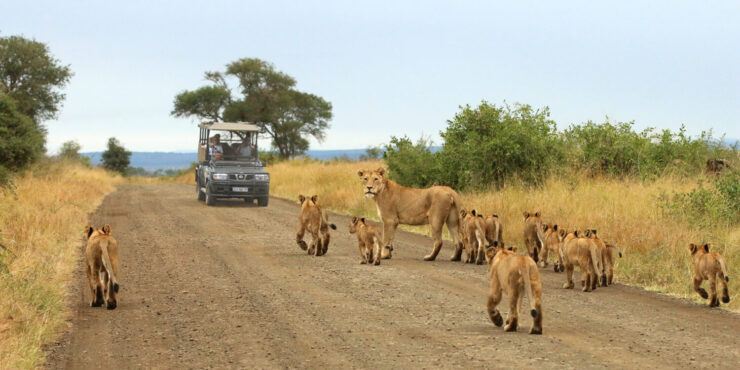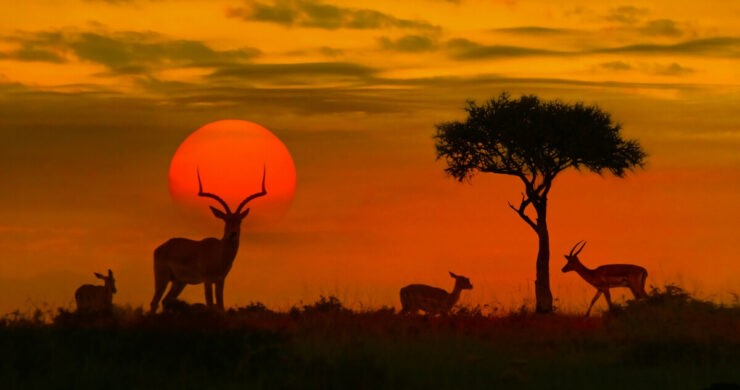Roaming freely through the vast savannah, the regal African lion surveys its kingdom. The golden grasses sway under the soft whisper of the wind, carrying with them the unspoken tales of the oldest wildlife sanctuary in South Africa. These are the mesmerizing scenes from Kruger National Park, the beating heart of South Africa’s wildlife heritage. A visit here isn’t just about seeking adventure; it’s an unforgettable journey of discovery.
GEOGRAPHICAL FEATURES

Kruger National Park is a landlocked jewel stretching over nearly 2 million hectares, showcasing a stunning range of topographical features. From the rolling hills in the south to the flat grasslands in the central region and the dense mopane veld in the north, each area has a unique aesthetic appeal. The varying landscapes, in turn, support an array of distinct habitats, enhancing the diversity of the park’s fauna and flora.
A number of rivers, including the Crocodile, Sabie, and Limpopo, crosscut the park, acting as lifelines for the teeming wildlife. These water bodies create an oasis effect, attracting large herds of elephants, buffalos, and antelopes, especially during dry spells. Majestic cliffs, rocky outcrops, and dense woodlands further enhance the park’s unique biodiversity. Check on this site how Kruger National Park safaris can give you one of the most visually enriching experiences ever.
HISTORY AND SIGNIFICANCE
Kruger National Park, named after President Paul Kruger, was established in 1898 to safeguard South Africa’s wildlife from extinction. His visionary efforts have culminated in one of the world’s most diverse and well-protected wildlife habitats. Over the years, the park has played a vital role in international conservation efforts, becoming a beacon for wildlife enthusiasts and conservationists worldwide. Today, this eco-paradise symbolizes a legacy of protection, preserving the true essence of Africa’s wild heart.
The sanctuary’s significance is not only ecological but also historical and cultural. Home to archeological sites like Masorini and Thulamela, Kruger provides a unique lens into South Africa’s ancient civilizations. These locations bear silent testimony to the region’s rich past, revealing the lives of people who co-existed with this diverse ecosystem thousands of years ago. It is a place where history and nature intertwine, making the park a repository of cultural heritage, as well as biodiversity.
BIODIVERSITY AND WILDLIFE

Kruger National Park is a treasure trove of wildlife. It boasts the ‘Big Five’ — lion, leopard, rhinoceros, elephant, and Cape buffalo — a term initially coined by hunters referring to Africa’s most dangerous animals. Now, it represents the quintessential safari experience, enticing wildlife enthusiasts to witness these magnificent creatures in their natural habitat.
Not only confined to the Big Five, the park hosts a wealth of other fauna. From the cheeky Chacma baboons to the agile impalas and the stately giraffes, the sanctuary is home to a staggering array of wildlife. Over 500 bird species, including the lilac-breasted roller and martial eagle, share the skies above. The park’s aquatic ecosystem is equally vibrant, hosting hippos, crocodiles, and a diversity of fish. In every sense, Kruger National Park is a living showcase of Africa’s rich biodiversity.
PLANNING YOUR TRIP
Crafting a well-planned itinerary is key to a fulfilling journey through Kruger National Park. Start by identifying what you’re most interested in seeing. Whether it’s the majestic Big Five, the lesser-known but equally fascinating small creatures, or the ancient archaeological sites, the park offers a plethora of options.
Consider your preferred mode of exploring. Self-drive safaris offer independence and flexibility, while guided tours provide expert insights into the park’s ecology and wildlife behavior. No matter what your preference, remember that patience is paramount. Wildlife sightings are unpredictable, and the best encounters often come to those who wait.
ACCOMMODATION OPTIONS
Kruger National Park offers a wide range of lodging choices, catering to every budget and preference. For those who prefer a taste of luxury in the wild, private lodges and campsites in the park’s concessions areas offer world-class amenities coupled with exclusive safari experiences. Imagine waking up to the lion’s roar or dining under the African stars!
Yet, the park is not only for luxury seekers. Budget travelers will find well-maintained rest camps with basic amenities such as barbecue facilities, grocery stores, and communal kitchens. Some of these camps even have hides overlooking water bodies, allowing for thrilling wildlife viewing right from your accommodations. Whichever option you choose, rest assured you will feel the authentic spirit of the African wilderness.
BEST TIME TO VISIT

When to visit Kruger National Park depends largely on what you aim to experience. The dry winter months from May to September are ideal for wildlife viewing. As water sources become scarce, animals congregate around waterholes, offering excellent sighting opportunities. The sparse vegetation and cooler temperatures make game drives more comfortable during this period.
The summer months from October to April bring heavy rains, turning the park into a lush, green paradise. This period marks the birthing season for many animals, making for unique wildlife viewing experiences. Migratory birds also flock to the park, making it a fantastic time for birdwatchers. Whichever season you choose, each offers a unique perspective on the park’s captivating charms.
SAFARI ACTIVITIES
The traditional game drive is just the beginning of your Kruger adventure. Safari walks offer a ground-level perspective, bringing you closer to the smaller, often overlooked, aspects of the ecosystem. Trained guides lead these walks, pointing out animal tracks, bird calls, and even medicinal uses of local plants. It’s a unique, intimate way to engage with the African bush.
If you crave a bird’s-eye view, consider a hot-air balloon safari. Ascending with the sun, you’ll witness the park’s stunning landscapes unfold beneath you while spotting wildlife from an entirely different perspective. It’s a breathtaking, tranquil experience, offering incredible photo opportunities and lifelong memories.
NIGHT DRIVES AND SUNSET SAFARIS

As the sun sets and the African sky unfolds a magnificent palette of colors, the park transitions into a whole new realm. Night drives and sunset safaris reveal the park’s nocturnal creatures, including leopards, hyenas, and owls. The guides’ spotlights reflecting in animals’ eyes create an eerie and exciting atmosphere, bringing you face-to-face with the mystical side of the wild.
For a more relaxing experience, opt for a sunset safari. These excursions often culminate in ‘sundowners,’ where you can sip a refreshing drink while basking in the mesmerizing hues of the African sunset. Whether you choose a night drive or a sunset safari, the allure of Kruger under the cloak of dusk is an experience not to be missed.
CLOSING REMARKS
With the falling of the evening light, as the southern cross takes over the African sky, Kruger National Park whispers the end of another day in its timeless wilderness. The park is more than a tourist attraction; it’s an immersive journey into the heart of Africa, weaving tales of adventure, history, and conservation. Your visit here not only leaves you with an awe-inspiring experience but also a renewed appreciation for our world’s diverse wildlife. By choosing Kruger, you also contribute to the invaluable conservation efforts safeguarding this extraordinary oasis of life.

